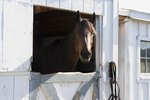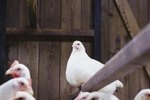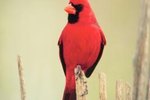Round hay bales are the common method for feeding livestock and horses in many areas. If hay is simply placed on the ground without any feeder, a percentage of the feed will be wasted when the animals walk on the hay that falls from the bale as the animals eat. Hay bale feeders are available commercially or can be built by the livestock owner.
Building a Round Hay Bale Feeder
Several university extension services provide plans for round bale feeders. Most plans are similar.
The plans developed by Louisiana State University Ag Center are for a square or rectangular feeder meant for round bales. Most home or farm workshops do not have the tools and equipment necessary for bending steel to construct a round feeder. The LSU design is meant to be placed permanently and fastened to the ground to prevent it from being overturned.
The plans can be modified to accommodate the size of the round bales being fed. The sides of the square feeder, or the short side of the rectangular feeder, should be 12 inches larger than the diameter of the round bales being fed. A roof over the feeder is optional. In areas where large amounts of rain are received, it may be advisable.
A rectangular feeder could be made large enough to accommodate two or even three hay bales. The feeder has a gate on one end to accommodate adding hay. It also allows the livestock owner access to the feeder to redistribute hay from the center to the edges where the livestock can reach it.
The feeder is constructed from 1 1/2-inch square steel tubing, 20inch round steal pipe and 20-gauge sheet metal. If the roof is constructed, 2-by-4 and 2-by-6 boards and corrugated steel roofing would also be needed. A variety of bolts and nails would also be required.
Construction of a round hay bale feeder will require power tools. A saw capable of cutting 2-inch steel pipe is required. A circular saw with a metal cutting blade would work, but a chop saw will make more accurate cuts. A power drill will also be needed.
Construction of the hay bale feeder will also require the use of a welder. The builder will need to have enough skill to make secure welds. Livestock reaching for feed can exert immense amounts of pressure on the bale feeder.
References
Writer Bio
Keith Allen, a 1979 graduate of Valley City State College, has worked at a variety of jobs including computer operator, medical clinic manager, radio talk show host and potato sorter. For over five years he has worked as a newspaper reporter and historic researcher. His works have appeared in regional newspapers in North Dakota and in "North Dakota Horizons" and "Cowboys and Indians" magazines.





